|
Click any typewriter
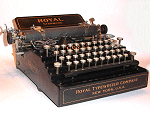
Royal 'Flatbed' - 1908
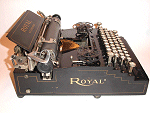
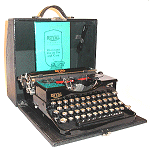
Royal Portable -
1926
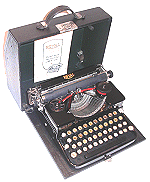
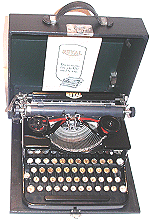


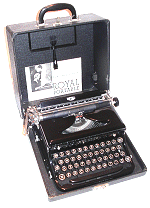
Royal Portable
Touch Control -1936
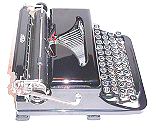
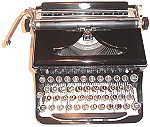


|
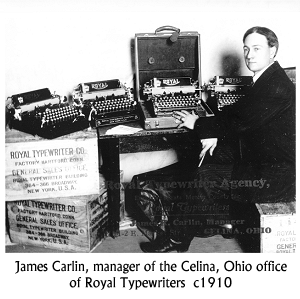
Royal
came later to the market than the other big manufacturers, Remington, Underwood
and Smith-Corona but, ultimately, it was to outperform them all. The
company was founded in New York in 1906 by financier Thomas Fortune Ryan and
perhaps the most prolific typewriter inventor of all, E. B. Hess. Hess secured
more than 200 patents, notably the accelerating typebar, giving Royal
its trade mark light touch. But the key innovation of the first machines
manufactured in a Brooklyn loft was the obvious desire to make the typewriter
compact and easy to carry - unlike every other desk machine on the market.
The 1906 Royal 'Flatbed' had a low profile and was provided with a leather
carrying case, as shown in the picture, right. The machine was far from a
true portable, as it weighed some 22 pounds, but this was clearly Hess's
goal. In 1906, however, business buyers were not ready for such
innovations and Flatbed sales were disappointing. When Royal moved
to a larger factory in Hartford, 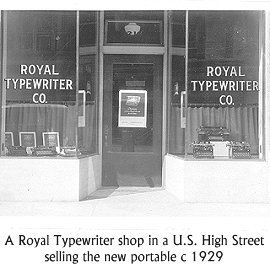 Connecticut,
Hess's first act was to design a new machine more in line with business
customers' expectation - a desk machine that looked more like an Underwood or a
Remington. Perhaps it was because of this early rebuff that Royal did not
launch its first portable
until 1926 -- six years behind Remington, seven behind Underwood and almost two
decades after Corona. However, from the start its machines were extremely
stylish and light to operate. And the company put into operation a global
advertising and PR programme to persuade its desk machine customers to buy the
new Royal Portable. Royal's flamboyant president, George Ed Smith, decided
that the most spectacular way of getting the new machines from the factory in
Hartford to the nationwide network of 2,100 dealers set up to sell
portables, was by air - then a revolutionary idea. He bought a Ford
Tri-motor plane and announced to his horrified factory staff that they were
going to parachute the portable machines to dealers. A total of 11,000
portables were parachuted all over America with
nervous Royal engineers standing by in the drop zones Connecticut,
Hess's first act was to design a new machine more in line with business
customers' expectation - a desk machine that looked more like an Underwood or a
Remington. Perhaps it was because of this early rebuff that Royal did not
launch its first portable
until 1926 -- six years behind Remington, seven behind Underwood and almost two
decades after Corona. However, from the start its machines were extremely
stylish and light to operate. And the company put into operation a global
advertising and PR programme to persuade its desk machine customers to buy the
new Royal Portable. Royal's flamboyant president, George Ed Smith, decided
that the most spectacular way of getting the new machines from the factory in
Hartford to the nationwide network of 2,100 dealers set up to sell
portables, was by air - then a revolutionary idea. He bought a Ford
Tri-motor plane and announced to his horrified factory staff that they were
going to parachute the portable machines to dealers. A total of 11,000
portables were parachuted all over America with
nervous Royal engineers standing by in the drop zones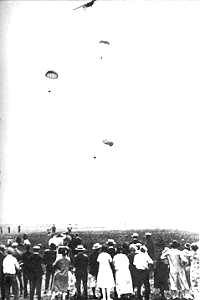 to unpackage the machines
and make sure they still worked. Amazingly, claimed the company, only half a dozen of the
11,000 machines were damaged -- through landing on their corners -- thus
achieving just the effect that Smith wanted to have on the buying public. The Royal Portable was so tough it would stand anything.
Perhaps being late to market assisted the Royal design team for, with its 1926
Portable, the designers had learned from their competitors to arrive at
the basic format and design that would stay with portable typewriters for
the next fifty years. Almost every one of the designers' decisions was
confirmed by the Underwood Four-Bank Portable launched in the same
year and looking uncannily similar. One curious fact from a collector's
standpoint is that this first Royal Portable ought to be a common machine yet it
is actually rather rare (only two or three a year come up on eBay). When
they do appear, they can sell for very little (I bought the mint example shown
here on eBay for £15) so it pays to keep your eyes open. Only the rather square, boxy shape
that Royal had always preferred marked out the Royal Portable as
different. After this extremely promising start in the portables market, Royal
not only caught up with its rivals, but overook them all by the 1950s to become
the world's largest typewriter manufacturer.
to unpackage the machines
and make sure they still worked. Amazingly, claimed the company, only half a dozen of the
11,000 machines were damaged -- through landing on their corners -- thus
achieving just the effect that Smith wanted to have on the buying public. The Royal Portable was so tough it would stand anything.
Perhaps being late to market assisted the Royal design team for, with its 1926
Portable, the designers had learned from their competitors to arrive at
the basic format and design that would stay with portable typewriters for
the next fifty years. Almost every one of the designers' decisions was
confirmed by the Underwood Four-Bank Portable launched in the same
year and looking uncannily similar. One curious fact from a collector's
standpoint is that this first Royal Portable ought to be a common machine yet it
is actually rather rare (only two or three a year come up on eBay). When
they do appear, they can sell for very little (I bought the mint example shown
here on eBay for £15) so it pays to keep your eyes open. Only the rather square, boxy shape
that Royal had always preferred marked out the Royal Portable as
different. After this extremely promising start in the portables market, Royal
not only caught up with its rivals, but overook them all by the 1950s to become
the world's largest typewriter manufacturer.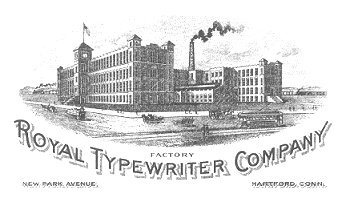 The Portable sold close to
1,400,000 machines between 1926 and 1947, outselling its early rivals. It was
followed by a number of other designs including the Safari, Signet, Junior, UR,
Model D, and several Royalite and Royaluxe models as well as the little Diana
machine recalled by many from the 1950s. The Safari machine sold an
amazing 1.5 million in the mid-1960s alone while the Royalite and Royaluxe models
sold nearly 4 million between 1955 and 1966, making Royal by far the best-selling
portable maker of all time. The machine shown here is the
Royal 'Touch Control' model of 1936, which enabled the typist to vary the resistance
of the keys by sliding a lever in the centre above the keys. One curious
incidental fact about Royal is that the glossy black paint finish on its early
portables has lasted better
than that of any other maker and, in most cases, still looks as good as new
today, misleading many inexperienced collectors into thinking either that they
have stumbled on a mint machine or that the typewriter is much more modern than
it really is -- an unexpected and belated tribute to the company's high
manufacturing and quality standards. The Portable sold close to
1,400,000 machines between 1926 and 1947, outselling its early rivals. It was
followed by a number of other designs including the Safari, Signet, Junior, UR,
Model D, and several Royalite and Royaluxe models as well as the little Diana
machine recalled by many from the 1950s. The Safari machine sold an
amazing 1.5 million in the mid-1960s alone while the Royalite and Royaluxe models
sold nearly 4 million between 1955 and 1966, making Royal by far the best-selling
portable maker of all time. The machine shown here is the
Royal 'Touch Control' model of 1936, which enabled the typist to vary the resistance
of the keys by sliding a lever in the centre above the keys. One curious
incidental fact about Royal is that the glossy black paint finish on its early
portables has lasted better
than that of any other maker and, in most cases, still looks as good as new
today, misleading many inexperienced collectors into thinking either that they
have stumbled on a mint machine or that the typewriter is much more modern than
it really is -- an unexpected and belated tribute to the company's high
manufacturing and quality standards.
In 1954, Royal merged with the McBee Corporation and for the next 10 years
traded as Royal McBee. In 1964 the joint company was acquired by
electronics giant Litton Industries, which also bought up Imperial
Typewriters. For several years in the 1960s, Royal and Imperial traded as
a single organisation but eventually succumbed to competition from Far East
producers and ceased manufacturing in 1968.
The Portable Typewriter Website
Copyright © Richard Milton 2003-2004
|
